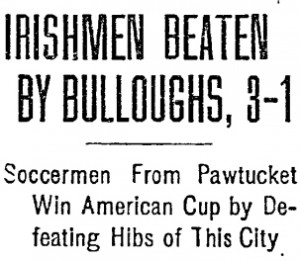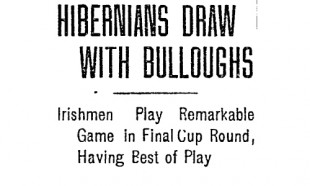When Philadelphia Hibernian met the defending American Football Association American Cup champs Tacony FC in Pennsylvania League play in the on March 18, 1911 at Tacony Ball Park at State and Unruh Street, they met a team itching for revenge. Not only had Tacony recently suffered its first loss in two years of league play against Collingwood FC—at team that along with Hibernian, Tacony and Philadelphia Thistle was one of four Philadelphia Teams who had made it to the second round of the American Cup—Tacony had recently been knocked out of the American Cup semifinals by Rhode Island’s Howard & Bullough.
Tacony took their revenge in a tough 2–1 win over the Hibs. The match report in the March 19 edition of the Philadelphia Inquirer concluded that Hibernian “will have to show decided improvement when they tackle Howard and Bullough in the American Cup final to win the trophy.”
The American Cup Final: April 9, 1911
Some 8,000 spectators were on hand to witness Hibernian take on Howard & Bullough at Morris Park in Newark, New Jersey, “the largest that has ever attended a final cup game.”
What they saw was “one of the fastest games ever witnessed at Morris park.”
With the Hibs having the wind at their backs “they had numerous chances in the first half.” But “over eagerness on the part of the frontliners” proved to be a problem. “Having only to touch the ball to land it into net,” center forward Gallagher missed an open goal from a delivery from Hinds at outside left. Only moments before the end of the half, a header from Gallagher “passed the post by only a few inches.”
At the half, the score stood at 0–0. The match report in the Inquirer says the Hibs forwards were “not being aggressive enough at close range.” And with so much of the Hibs attack coming through crosses from Hinds, the Howard & Bullough right fullback O’Toole “covered himself in glory” in thwarting his play.
Although Hinds “was too well watched to play his usual game…with a man generally hanging onto him when he received possession,” he nevertheless provided the opening that gave Hibernian the lead 25 minutes into the second half. “After making a splendid run he proved what a great player he is by making the opening which lowered the Bulloughs’ goal.” Hibs “passed and repassed the ball before finally feeding Burrows, who was well placed” to score.
“It looked by the manner the Irishmen were playing after they scored that the Rhode Islanders were due to take the silver medals,” the Inquirer reported, “but they brightened up considerably toward the close and gave the Quakers lots of anxiety by their narrow shaves near goal.” With ten minutes left to play, Howard & Bullough outside left Cannan got past Hibernian right half Waltemate—described by the Inquirer as “not a success, as he left his opposing wing entirely too much leeway in getting started”—and connected a low header to even the score. With Howard & Bullogh pouring it on, only some “brilliant stunts” by the Hibs keeper O’Donnell kept the score even at 1–1 when the final whistle blew.
The American Cup final was going to a replay.
 Back in Philadelphia
Back in Philadelphia
With the American Cup replay only two weeks away, Hibernian were faced with a difficult choice. Their rematch with Tacony in the Pennsylvania League was scheduled for April 22, just a day before the replay: should they forfeit the game to Tacony, who had defeated them on March 18 in a close 2–1 game and so essentially forfeit their chance at the Pennsylvania League title? Hibernian chose to forfeit.
In the meanwhile, Philadelphia’s representative in the American Cup played Fall River Rovers in an exhibition game on April 17 at Second and Allegheny. The last time the Massachusetts team had been in Philadelphia they had been knocked out of the semifinals of 1910 American Cup by eventual champions Tacony, 2–1. Their bad luck in Philadelphia continued with a 3–0 drubbing by Hibernian. Though the Inquirer match report on April 18 said that “there was little to choose between the teams in the first period,” the half ended with Hibs up 1–0 on a goal from Gallagher.
“It was the last half where the Hibernians began to show the form that has placed them the leading team in the country,” the Inquirer reported, as “the Irishmen seemed to be right on the job, their passing being the best witnessed on the Second Street grounds this season.” The Inquirer concluded, “if they should repeat yesterday’s display they will have nothing to fear when they tackle Howard and Bullough in the replay next Sunday.”
The 1911 American Cup Final replay: April 23, 1911
Noting the “unusual amount of interest among the followers of the Irishmen in this city,” the match preview on the April 23 edition of the Inquirer stated that, “it is the universal opinion that the Hibernians will go one better this afternoon and lift the trophy, which is now held by Tacony.”
But all was not well in the Hibernian camp.
“A great deal of uneasiness is manifested among the Irishmen at the present time,” the Inquirer reported, “on account of Billy Gallagher, their sterling center forward, not being in the best of shape, and it more than likely that he will not be able to play in his accustomed position against the Bulloughs.” The match preview continued,
Manager Currie stated last night that he will have no end of trouble in picking out a player among the thirteen eligible to play to put in Gallagher’s place. The followers of the Irishmen are backing their champions to win this afternoon, but should the elven have to take the field minus Gallagher it will materially weaken their chances of winning the game.
In the end, Gallagher did play in the replay, which took place in front of more than 6,000 spectators at Morris Park.
As was the case in the first match, the Hibs once again started with the wind at their backs. The match report in the April 24 edition of the Inquirer says “their followers were jubilant at the start of the game by the manner in which the players got down to work.” But the Philadelphia side found their opponents equal to their attack, O’Toole once again shutting down the Hibs’ dangerous left flank, and the first half ended scoreless. The best chance for the Hibernians happened just before the whistle, with Burrows receiving the ball in his own half and dribbling past two defenders before firing a low shot that went just wide. “It was a splendid attempt,” said the match report in the Inquirer, “and worthy of better results.”
Hibernian finally got on the board after fifteen minutes of play in the second half “when Hinds, the outside left of the Hibernians, whipped in a cross shot which Burrows connected with at the mouth of the goal.”
Howard & Bullough “tallied right from the goal kick,” with inside right McKay “doing the needful.”
Soon after, Howard & Bullough took the lead after outside right Harvey converted a penalty kick resulting by from a hand ball from Hibernian captain and left fullback Wilson. Minutes late, Harvey sealed the victory. While Wilson and left halfback Tillie “were waiting for each other to boot the ball out of danger, Harvey nipped in between the pair and before they could recover the sphere the ball was in the net out of reach of the custodian who had not the slightest chance of stopping the ball.”
Final score: Howard & Bullough 3, Philadelphia Hibernian 1.
The Inquirer concluded, “There is not the least doubt that the half-back line of the Irishmen was responsible for the team’s defeat.” Not that the forwards played their best game, either. Hampered by O’Toole—”easily the star of the day, and it was mainly through his splendid exhibition that the Bulloughs won the game”—the Hibernian frontline was “slow in comparison to the fleet-footed front rankers of their opponents, who were quick on the ball. Had the wearers of the green played up to their reputation, the game would have been more exciting.”
So, a Philadelphia team would not repeat as winner of the American Cup. Tacony would make it to the finals in 1913 only to lose to Paterson True Blues. In 1914, Tacony would again reach the finals to face Bethlehem Steel. It would be the beginning of a dynasty of success for Bethlehem Steel, the greatest team in the early history of soccer in the United States.



Comments